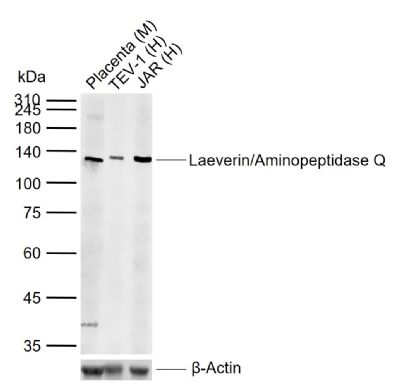Laeverin is a 990 amino acid member of the peptidase M1 family and contains an HEXXHX18E gluzincin motif and an H(G)AMEN motif. Expressed specifically in placenta on embryo-derived extravillous trophoblasts (EVTs), laeverin localizes to the cell membrane and is a single-pass type II membrane protein. Laeverin binds zinc and functions as a bestatin-sensitive leucine aminopeptidase with a potential role in EVT function. This suggests that laeverin may be involved in human placentation, during which EVTs invade maternal decidua and spiral areteries. More specifically, laeverin may function by regulating the activities of key peptides at the embryo-maternal interface. Laeverin has a broad substrate specificity but exhibits a preference for Leu-4-methylcoumaryl-7-amide. In addition, laeverin can form a homodimer with intermolecular disulfide bond(s).
Function:
Metalloprotease which may be important for placentation by regulating biological activity of key peptides at the embryo-maternal interface. On synthetic substrates it shows a marked preference for Leu-4-methylcoumaryl-7-amide (Leu-MCA) over Met-MCA, Arg-LCA and Lys-LCA. Cleaves the N-terminal amino acid of several peptides such as angiotensin-3, kisspeptin-10 and endokinin C.
Subcellular Location:
Membrane.
Tissue Specificity:
Specifically expressed in placenta and not in other tissues. Mainly found at the cell surface region of the extravillous trophoblasts. Detected on extravillous trophoblasts in the outer layer of the chorion laeve in the fetal membrane Not detected on either fetal amnionic epithelial cells or maternal decidual cells. Also detected in the migrating extravillous trophoblasts in the maternal decidual tissues (at protein level).
Post-translational modifications:
N-glycosylated.
Similarity:
Belongs to the peptidase M1 family.
SWISS:
Q6Q4G3
Gene ID:
206338
Database links:
Entrez Gene: 206338 Human
GenBank: BC045809 Human
Omim: 610046 Human
SwissProt: Q6Q4G3 Human
Unigene: 98288 Human
| Picture |
Sample:
Lane 1: Mouse Placenta tissue lysates
Lane 2: Human THP-1 cell lysates
Lane 3: Human JAR cell lysates
Primary: Anti-Laeverin/Aminopeptidase Q (SL16883R) at 1/1000 dilution
Secondary: IRDye800CW Goat Anti-Rabbit IgG at 1/20000 dilution
Predicted band size: 113 kDa
Observed band size: 120 kDa
|
|
|
